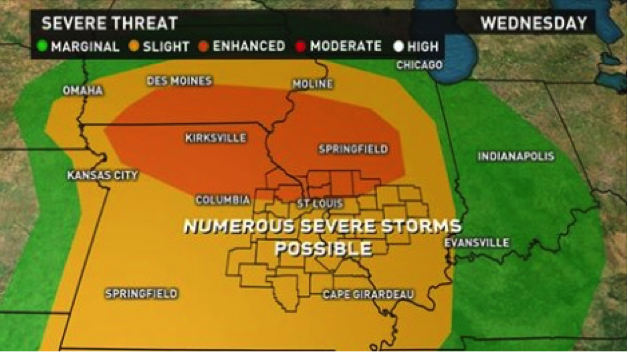The (in)exact science of weather forecasting
Meteorologists tell us they are getting better and better at forecasts, especially in the near term.
Well, not always.
On November 2 at noon in St. Louis, there was a tale of two forecasts.
At KSDK’s Channel 5 Mike Roberts predicted a high of 75 after a foggy morning.
But at Channel 4, KMOV, Meghan Danahey said that based on the fog, she was lowering her estimated high that afternoon to “near 70.”
Danahey was right. The high hit 71. It is a reminder that weathercasters still might need to go with their gut, depending on changing conditions.
Channel 4 has been the winner of a weather accuracy award for several years. Channel 5 used the same award to brag until Channel 4 took top honors.
The station wrote in a news release, “The honor comes from the independent firm WeatheRate who monitored the forecasts for all of the news stations in St Louis each day for an entire year, and then named KMOV the most accurate.”
On this particular day, that was indeed the case.
Eight days later, Danahey again served viewers better than Roberts at noon. For days, all the stations were predicting severe storms for Wednesday, Nov. 11.
Things began changing by the day before.
The National Weather Service has various categories for the potential of bad weather moving from “marginal” to “slight” to “enhanced” to “moderate” to “high.”
On Monday, two days before the predicted event, we were nearly dead center in the highest risk for that day, the “enhanced risk.”
By Tuesday morning, the enhanced risk moved further north, with the St. Louis metro area being on the southern end of the end of the greatest risk. The metro area was now in the slight risk category. But by 12:15 PM, the highest risk had moved north of the metro area. (Screenshot below from KSDK Facebook page).
To her credit, Danahey made a big point about the fact that in the last few minutes, the greatest threat moved to north of the area so viewers might relax a little (though she did make a point of saying there was still a threat – just a lesser one).
Roberts did not point out to viewers the big threat eased north. Instead, he said we were still in the “bull’s eye” for severe weather, which was no longer correct.
Channel 4’s Danahey better served viewers by noting how things were changing.
While it’s a small thing, this difference can be substantial for viewers. Many viewers hear about severe weather and get scared.
Accurate information is important. And when really bad weather is approaching, at that point, a bit of fear may be appropriate to get people to protect themselves.
But it is not okay to scare people days in advance as, in this case, all the stations were doing? No.
Advise? Yes. Scare? No.
Despite the hype, the severe weather never materialized in the St. Louis area. In fact, the line of storms completely missed. To his credit, Dave Murray acknowledged on the 9 p.m. news on Fox2 (KTVI) how badly the forecasters messed up.
